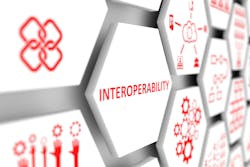What’s Information Blocking? Survey Reveals Lack of Awareness Around New Rule
As of yesterday, healthcare stakeholders must now comply with certain information-blocking components of the Office of the Coordinator for Health IT’s (ONC’s) Cures Act final rule, but a new survey finds that across the industry, there’s still a broad lack of awareness around information blocking.
The survey, conducted by medical imaging company Life Image, also indicates general confusion around the rule requirements and the specific steps organizations must take to prepare. Findings from the March 2021 survey—which included responses from more than 300 clinical, technology and administrative leaders from provider, payer, IT, and other organizations—were released on April 6, just one day after the compliance start date for some of the information-blocking elements of the final rule. The most represented group of stakeholders in the survey were providers, who made up 43 percent of all respondents.
Finalized for the public last year, the ONC regulation established exceptions to the 21st Century Cures Act’s information-blocking provisions and adopted new health IT certification requirements to enhance patients’ smartphone access to their health information at no cost through the use of application programming interfaces (APIs). In their broadest sense, ONC’s information-blocking rules are designed to assist in the free flow of patient information across the healthcare ecosystem.
The information-blocking concept was originally defined by Congress in the Cures Act, and the concept entails interfering with, preventing, or materially discouraging access, exchange, or use of electronic health information. Information blocking “is a practice that is profoundly anti-consumer and anti-competition. Information blocking can be used to increase revenue, escalate prices, and prevent market competition both for current and future competitors and for new services,” according to the Cures Act. The Cures Act law tasked ONC to define what doesn’t constitute data blocking, and agency’s final regulation released last year clarifies where penalties will be enforced and exceptions granted. The rule specifically applies to providers, health IT vendors, health information exchanges (HIEs), and health information networks.
In the final rule, ONC set compliance dates and timeframes to meet certain requirements related to the information-blocking and conditions and maintenance of certification (CoC/MoC) requirements. Due to the pandemic, the condition of certification for information blocking was delayed until November, and then, in late October, that start date was pushed back again, this time until April 5. Per the rule, there are seven conditions of certification and most have an accompanying maintenance of certification requirement.
While 70 percent of participants in the Life Image survey stated they were aware of the rules going into effect, up to half of the same individuals also reported using practices that are defined by ONC as information blocking and will be noncompliant under the new rules – such as sharing records via paper or CDs, or charging patients fees to obtain records.
Additional notable findings from the survey included:
- Nearly half of the respondents had either not made any changes or did not know how to ensure their facility meets all of the rule requirements
- A majority of healthcare organizations reported not using digital solutions to share healthcare data with patients, with 66 percent still using paper and 32 percent using CDs
- 47 percent were not familiar with the term “information blocking”
- 48 percent were not aware of practices or policies that would be considered “information blocking”
- 39 percent did not know they could incur civil monetary penalties for information blocking practices
- 15 percent currently charge $25 or more for patients to obtain records. 57 percent said they don’t charge any fees, and 28 percent said they charge $10 or less.
Officials from Life Image pointed out that under federal HIPAA law, providers must give patients, upon request, access to their protected health information in the form and format of the individual’s choosing, including electronic format and via third-party application. In order to address ongoing industry resistance and barriers to interoperability, the Cures Act regulations mandate that patients be allowed greater control and access to their health data, targeting vendors and technologies that block information access.
“Our recent survey validates what Life Image has been witnessing across the healthcare ecosystem in terms of interoperability readiness. While the COVID-19 pandemic created massive challenges and delayed many interoperability initiatives, it also underscored the paramount importance of the final ONC rules for advancing patient care and driving innovation,” Matthew A. Michela, president and CEO, Life Image, said in statement. “As many organizations are facing a long, complicated journey to ONC compliance, we’re dedicated to helping the industry navigate this new data revolution.”
David Schoolcraft, Partner and Chair of the Digital Health Group at Ogden Murphy Wallace, added, “This landmark regulation is also a massive undertaking as many stakeholders are currently non-compliant and are struggling to navigate the regulatory complexities,” he said. “As ONC starts enforcement, organizations must prioritize deepening their knowledge of these mandates and implementing changes to adapt to the evolving landscape, or run the risk of incurring significant penalties.”
Indeed, the regulations from federal policymakers will penalize stakeholders who engage in information blocking that prevents the flow of health data, with “bad” actors subject to fines of up to $1 million per information-blocking violation.
A separate, recent survey of health information exchange executives, led by health policy researcher Julia Adler-Milstein, Ph.D., of the UCSF School of Medicine, found that the majority of respondents—55 percent—reported that electronic health record (EHR) vendors still at least sometimes engage in information blocking, while 30 percent of HIEs reported the same for health systems.


